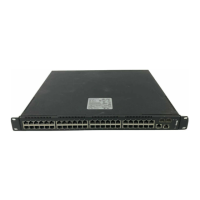Layer 2,3,IPv6+QoS Switch
_____________________________________________________________________________
Layer 2,3,IPv6+QoS Network Switch User Manual Version 0.1 Page: 47/970
3 Console and Telnet Administration Interface
This chapter discusses many of the features used to manage the Switch, and explains
many concepts and important points regarding these features. Configuring the Switch to
implement these concepts is discussed in detail in chapter 6.
3.1 Local Console Management
Local console management involves the administration of the Switch via a direct
connection to the RS-232 DCE console port. This is an Out-of-band connection, meaning that it
is on a different circuit than normal network communications, and thus works even when the
network is down.
The local console management connection involves a terminal or PC running terminal
emulation software to operate the Switch’s built-in console program (see Chapter 6). Using the
console program, a network administrator can manage, control, and monitor many functions of
the Switch. Hardware components in the Switch allow it to be an active part of a manageable
network. These components include a CPU, memory for data storage, other related hardware,
and SNMP agent firmware. Activities on the Switch can be monitored with these components,
while the Switch can be manipulated to carry out specific tasks.
3.2 Set Up your Switch Using Console Access
Out-of-band management requires connecting a terminal, such as a VT-100 or a PC
running a terminal-emulation program (such as HyperTerminal, which is automatically installed
with Microsoft Windows) to the RS-232 DCE console port of the Switch. Switch management
using the RS-232 DCE console port is called Local Console Management to differentiate it
from management done via management platforms, such as DView or HP OpenView.
Make sure the terminal or PC you are using to make this connection is configured to
match these settings. If you are having problems making this connection on a PC, make sure
the emulation is set to VT-100 or ANSI. If you still don’t see anything, try pressing <Ctrl> + r to
refresh the screen.
First-time configuration must be carried out through a console, that is, either (a) a
VT100-type serial data terminal, or (b) a computer running communications software set to
emulate a VT100. The console must be connected to the Diagnostics port. This is an RS-232
port with a 9-socket D-shell connector and DCE-type wiring. Make the connection as follows:
1. Obtain suitable cabling for the connection.
You can use a null-modem RS-232 cable or an ordinary RS-232 cable and a null-modem
adapter. One end of the cable (or cable/adapter combination) must have a 9-pin D-shell
connector suitable for the Diagnostics port; the other end must have a connector suitable
for the console’s serial communications port.
2. Power down the devices, attach the cable (or cable/adapter combination) to the correct
ports, and restore power.
3. Set the console to use the following communication parameters for your terminal:

